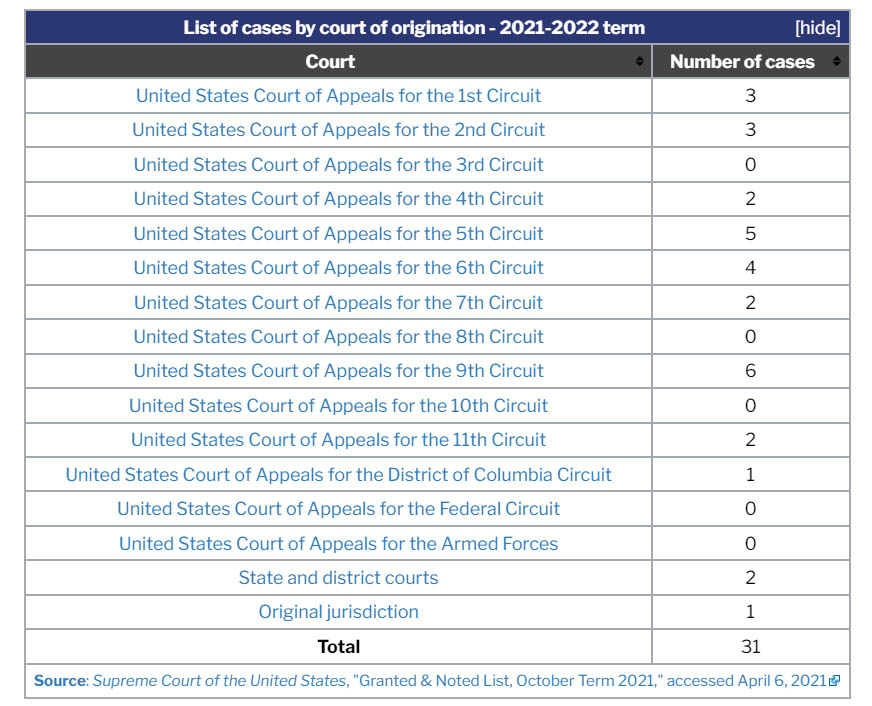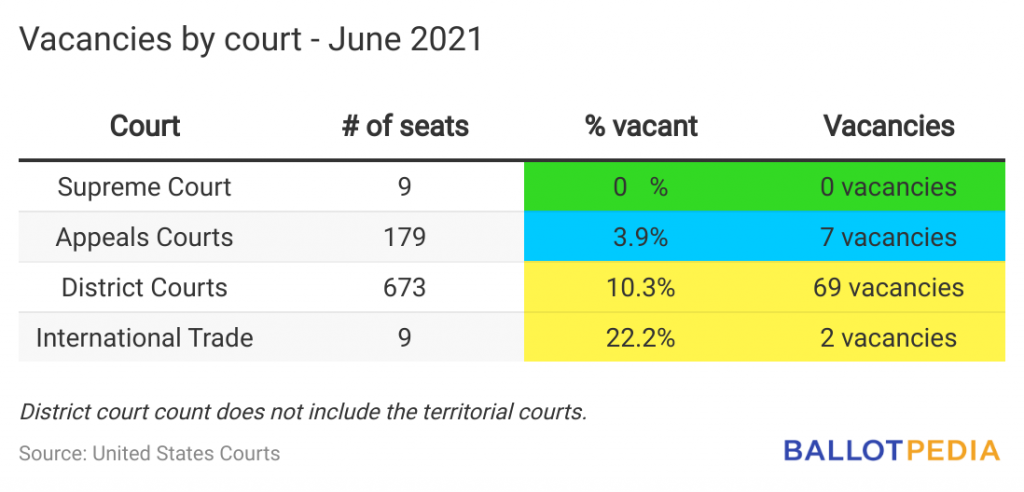
Welcome to the July 12 edition of Bold Justice, Ballotpedia’s newsletter about the Supreme Court of the United States (SCOTUS) and other judicial happenings around the U.S.
SCOTUS may be in its summer recess but we are gaveling in to bring you all the latest court activity on the docket: the end of SCOTUS’ 2020 term, the 2021 term on the horizon, and the first federal judicial confirmations of the Biden administration.
Stay up to date on the latest news by following Ballotpedia on Twitter or subscribing to the Daily Brew.

Grants
SCOTUS accepted 13 cases to its merits docket since our June 7 issue. To date, the court has agreed to hear 31 cases for the upcoming 2021-2022 term, which is scheduled to begin on October 4, 2021.
Click the links below to learn more about these cases:
- Federal Bureau of Investigation v. Fazaga concerns the state-secrets privilege.
- City of Austin, Texas v. Reagan National Advertising of Texas, Inc. concerns the constitutionality of a municipal sign code.
- Patel v. Garland concerns federal courts’ authority and jurisdiction to review eligibility findings in immigration appeals.
- Carson v. Makin concerns public education funding and religious education, and the U.S. Supreme Court’s decision in Espinoza v. Montana Department of Revenue (2020).
- United States v. Taylor, involves the Hobbs Act and the definition of a “crime of violence.”
- Cummings v. Premier Rehab Keller, P.L.L.C. involves federal disability laws and whether they allow the petitioner to be awarded compensatory damages for emotional distress.
- Hughes v. Northwestern University concerns Employee Retirement Income Security Act of 1974 (ERISA) defined-contribution retirement plans.
- Becerra v. Empire Health Foundation concerns the U.S. Department of Health and Human Services’ (HHS) authority to change the hospital reimbursement formula when a federal court ruled that the law was clear on how the agency should calculate those payments.
- CVS Pharmacy, Inc. v. Doe involves disability discrimination claims under the Rehabilitation and Affordable Care Acts.
- Gallardo v. Marstiller concerns tort claims and state Medicaid program reimbursement.
- American Hospital Association v. Becerra concerns whether the Chevron deference doctrine permitted HHS’ interpretation of the Medicare statute allowing the agency to lower the reimbursement rate.
- Pivotal Software, Inc. v. Tran involves the Private Securities Litigation Reform Act’s (PSLRA) discovery-stay provision, which halts the discovery process in a case.
- Mississippi v. Tennessee concerns a dispute between Mississippi and Tennessee involving an aquifer’s groundwater.

Opinions
SCOTUS issued opinions in 26 cases since our June 7 issue. The court issued 67 opinions during its 2020-2021 term. Two cases were decided in one consolidated opinion. Ten cases were decided without argument.
Click the links below to review the court’s rulings in the most recently decided cases:
June 7, 2021
June 10, 2021
June 14, 2021
June 17, 2021
- Fulton v. City of Philadelphia, Pennsylvania
- California v. Texas (Consolidated with Texas v. California)
- Nestlé USA v. Doe I (Consolidated with Cargill v. Doe I)
June 21, 2021
- Goldman Sachs Group Inc. v. Arkansas Teacher Retirement System
- National Collegiate Athletic Association v. Alston (Consolidated with American Athletic Conference v. Alston)
- United States v. Arthrex Inc. (Consolidated with Smith & Nephew Inc. v. Arthrex Inc. and Arthrex Inc. v. Smith & Nephew Inc.)
June 23, 2021
- Lange v. California
- Collins v. Yellen (Consolidated with Yellen v. Collins)
- Mahanoy Area School District v. B.L.
- Cedar Point Nursery v. Hassid
June 25, 2021
- TransUnion LLC v. Ramirez
- HollyFrontier Cheyenne Refining, LLC v. Renewable Fuels Association
- Yellen v. Confederated Tribes of the Chehalis Reservation (Consolidated with Alaska Native Village Corporation Association v. Confederated Tribes of the Chehalis Reservation)
June 28, 2021
- Lombardo v. City of St. Louis, Missouri (Decided without argument)
- Pakdel v. City and County of San Francisco, California (Decided without argument)
June 29, 2021
July 1, 2021
- Brnovich v. Democratic National Committee (Consolidated with Arizona Republican Party v. Democratic National Committee)
- Americans for Prosperity v. Bonta (Consolidated with Thomas More Law Center v. Bonta)
July 2, 2021
- Dunn v. Reeves (Decided without argument)
Upcoming SCOTUS dates
The court held its final conference and issued its final opinions for the term on July 1, 2021. The court issued its final order list on July 2, 2021, before starting its summer recess. The court will resume hearing arguments in October.

True or false: have there ever been any Supreme Court justices with the same name?
Choose an answer to find out!

The Federal Vacancy Count tracks vacancies, nominations, and confirmations to all United States Article III federal courts in a one-month period. This month’s edition includes nominations, confirmations, and vacancies from June 1 to July 1.
Highlights
- Vacancies: There have been three new judicial vacancies since the May 2021 report. There are 78 vacancies out of 870 active Article III judicial positions on courts covered in this report. Including the United States Court of Federal Claims and the United States territorial courts, 82 of 890 active federal judicial positions are vacant.
- Nominations: There have been 11 new nominations since the May 2021 report.
- Confirmations: There have been seven confirmations since the May 2021 report.
Vacancy count for July 1, 2021
A breakdown of the vacancies at each level can be found in the table below. For a more detailed look at the vacancies on the federal courts, click here.

*Though the United States territorial courts are named as district courts, they are not Article III courts. They are created in accordance with the power granted under Article IV of the U.S. Constitution. Click here for more information.
New vacancies
Three judges left active status, creating Article III life-term judicial vacancies, since the previous vacancy count. As Article III judicial positions, the president nominates individuals to fill the vacancies. Nominations are subject to U.S. Senate confirmation.
- Judge John Dowdell assumed senior status on the U.S. District Court for the Northern District of Oklahoma.
- Judge Lydia Kay Griggsby left her seat on the U.S. Court of Federal Claims when she was elevated to the U.S. District Court for the District of Maryland.
- Judge Ketanji Brown Jackson left her seat on the U.S. District Court for the District of Columbia when she was elevated to the U.S. Court of Appeals for the District of Columbia Circuit.
The following chart tracks the number of vacancies in the United States Courts of Appeals from the inauguration of President Joe Biden (D) to the date indicated on the chart.
U.S. District Court vacancies
The following map shows the number of vacancies in the United States District Courts as of July 1, 2021.
New nominations
President Biden has announced 11 new nominations since the May 2021 report.
- Toby Heytens, to the United States Court of Appeals for the 4th Circuit
- Myrna Pérez, to the United States Court of Appeals for the 2nd Circuit
- Jennifer Sung, to the United States Court of Appeals for the 9th Circuit
- Jane Beckering, to the United States District Court for the Western District of Michigan
- Jia Cobb, to the United States District Court for the District of Columbia
- Shalina Kumar, to the United States District Court for the Eastern District of Michigan
- Sarah A.L. Merriam, to the United States District Court for the District of Connecticut
- Michael Nachmanoff, to the United States District Court for the Eastern District of Virginia
- Sarala Nagala, to the United States District Court for the District of Connecticut
- Patricia Tolliver Giles, to the United States District Court for the Eastern District of Virginia
- Omar A. Williams, to the United States District Court for the District of Connecticut
New confirmations
As of July 1, 2021, the Senate has confirmed seven of President Biden’s judicial nominees—five district court judges and two appeals court judges—since January 2021.
- Ketanji Brown Jackson, to the United States Court of Appeals for the District of Columbia Circuit
- Candace Jackson-Akiwumi, to the United States Court of Appeals for the 7th Circuit
- Deborah Boardman, to the United States District Court for the District of Maryland
- Lydia Kay Griggsby, to the United States District Court for the District of Maryland
- Julien Xavier Neals, to the United States District Court for the District of New Jersey
- Zahid Quraishi, to the United States District Court for the District of New Jersey
- Regina Rodriguez, to the United States District Court for the District of Colorado
The first confirmations occurred on June 8, when Julien Neals and Regina Rodriguez were confirmed to their respective courts. Ketanji Brown Jackson, who was confirmed on June 14, was the first confirmed nominee to receive her judicial commission. Jackson was commissioned on June 17.
Since 1981, only two other presidents had confirmed Article III judicial nominees by July 1 of their first year in office: Presidents Donald Trump (R) and George H.W. Bush (R), each with four confirmed nominees.
Need a daily fix of judicial nomination, confirmation, and vacancy information? Click here for continuing updates on the status of all federal judicial nominees.
Or, keep an eye on this list for updates on federal judicial nominations.
Hello, gentle readers! Put a quarter in the jukebox and grab a malted milkshake with me as we be-bop-a-Lula our way through federal judicial history. Today’s edition of Bold Justice highlights President Dwight Eisenhower’s (R) federal judicial nominees from 1953 to 1961.
During his time in office, 175 of President Eisenhower’s judicial nominees were confirmed. One nominee declined the nomination, two were withdrawn, and the U.S. Senate did not vote on 26 nominees. Among the most notable appointees were five Supreme Court Justices:
- Earl Warren, commissioned in 1954.
- John Harlan II, commissioned in 1955.
- William Brennan, commissioned in 1957.
- Charles Whittaker, commissioned in 1957.
- Potter Stewart, commissioned in 1959.
President Eisenhower’s first Article III appointee was confirmed on April 23, 1953—Judge Lester Cecil to the U.S. District Court for the Southern District of Ohio. By the end of his first year in office, nine of Eisenhower’s nominees had been confirmed–all nine were confirmed to U.S. district courts. Eisenhower averaged 22.7 judicial appointments per year. For comparison, President Jimmy Carter (D) had the highest average from 1901 to 2021 with 65.5 appointments per year.
We’ll be back on July 19 with a new edition of Bold Justice. Until then, gaveling out!
Contributions
Kate Carsella and Brittony Maag compiled and edited this newsletter, with contributions from Jace Lington, and Sara Reynolds.



